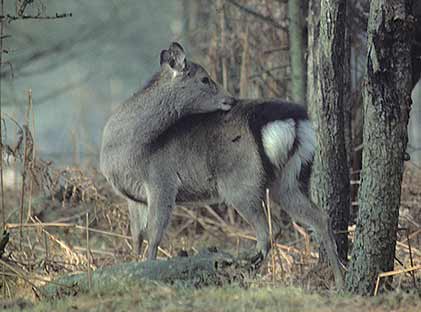New Forest deer: obtain closer views - clothing and equipment
Here is some advice on the clothing and equipment that will help ensure good, close views of New Forest deer.

that she is being watched
For stalking deer, equipment needs are minimal, and amount to a pair of reasonable quality binoculars that will help when initially locating the animals, and again throughout the stalking process.
Clothing needs for stalking deer are similarly modest, and consist largely of common sense purchases:
Colours
Clothing should be of subdued colour, allowing the watcher to blend in with the landscape. Avoid, for example, brightly coloured jackets - it’s surprising how many times people are seen in the New Forest, equipped with binoculars and clearly intent on watching deer, but wearing bright yellow, blue or red anoraks that significantly reduce the chances of success. Perhaps not surprisingly, greens, browns and appropriately camouflaged patterns are best.
Material
Jackets and trousers made of soft material are far superior to those made of nylon or other synthetic materials – the latter have a horrible tendency to rustle when in use, and make further noise when brushed against vegetation.
Boots
Use of strong, waterproof boots is highly desirable in the New Forest at most times of the year – the ground can be very wet, and it’s sometimes necessary to cross drainage channels and streams. Wellington boots, though, should be avoided, as it’s incredibly difficult to walk quietly in these.
Headgear
A hat or face covering will soften the conspicuous effect of a pale face against a darker background - notice people at a distance in the countryside to see what I mean: it’s often the face that’s most obvious. A peaked cap or brimmed hat will help break up the outline of the face, but better still is green, fine grade netting draped over the face; a balaclava or similar face covering; or use of camouflage paint. Beware, though, the disconcerting effect on passers-by that netting, balaclavas and face paint can have!
Gloves
Dark coloured gloves help cover conspicuously white hands raised with binoculars or camera. Thin, fingerless gloves or gloves with forefinger and thumb cut out are particularly helpful for camera use.
New Forest deer - obtain closer views
New Forest deer - find out lots more
References:
The History of British Mammals: Derek Yalden
Roe Deer: John K. Fawcett, British Deer Society
New Forest Roe Deer: John K. Fawcett
Deer Watch: Richard Prior
Mammals of Britain and Europe: David McDonald, Priscilla Barret
Field Guide to British Deer: F J Taylor Page
More links
Other related links
Search this site

Sadly, 58 animals were killed - 35 ponies, 13 cows, 8 donkeys and 2 sheep, whilst a further 32 were injured - 3 pigs, 9 donkeys, 11 cows and 9 ponies.
(Forty-three accidents occurred in daylight, 15 at twilight and 101 in the dark. Twenty-seven accidents were not reported by the driver involved).
Here's just one horrific example - Three donkeys killed in collision with van at notorious New Forest blackspot (Advertiser and Times)

